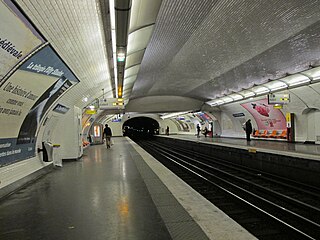
La Tour-Maubourg is a station on line 8 of the Paris Métro. The station is located next to Les Invalides.

Marie-Victor-Nicolas de Faÿ, marquis de La Tour-Maubourg was a French cavalry military commander under France's Ancien Régime before rising to prominence during the First French Empire.

Ettore Perrone, Conte di San Martino was an Italian politician and military leader.
The Musée de l'Ordre de la Libération is a military museum located in the 7th arrondissement at 51 bis boulevard de La Tour-Maubourg, Paris, France. It is open daily except Sunday; admission is free. The museum is dedicated to the Ordre de la Libération, France's second national order after the Légion d'honneur, which was created in 1940 by General Charles de Gaulle, leader of the Free French Forces. In 1967 de Gaulle moved the Order of the Liberation into Les Invalides. The museum contains three galleries and six rooms documenting the history of the Free French Forces, de Gaulle's manuscripts, resistance activities, and the concentration camps. Showcases contain more than 4,000 objects including uniforms, weapons, clandestine press and leaflets, transmitters, flags taken to the enemy on the battlefields of Africa and Europe, the first naval flags of Free France, and relics from the camps. The hall of honor is dedicated to General de Gaulle.

Marie Adrienne Françoise de Noailles, Marquise de La Fayette, was a French marchioness. She was the daughter of Jean de Noailles and Henriette Anne Louise d'Aguesseau, and married Gilbert du Motier, Marquis de Lafayette.
Adrienne Catherine de Noailles, comtesse de Tessé, was a French salon holder and letter writer. She was daughter of Louis, 4th duc de Noailles, sister of the 5th duc de Noailles and aunt of Marie Adrienne Françoise de Noailles, held a salon and corresponded with Thomas Jefferson in the early 19th century.

The House of La Fayette was a French family of Nobles of the Sword, from the province of Auvergne, established during the Middle-Age by the lords of the fief of La Fayette held by the senior branch of the Motier family.
Romain-Joseph de Brigode-Kemlandt (1775–1854) was a baron of the Empire, owner of Annappes.
Louis Saint Ange Morel, chevalier de la Colombe (1755–1799) was an aide de camp to Gilbert du Motier, marquis de Lafayette, during the Revolutionary War.

The Cimetière Saint-Pierre is the largest cemetery in the town of Marseille, France.

I Cavalry Corps was a French military formation that existed during the Napoleonic Wars. For one month in 1806–1807, Emperor Napoleon split his Reserve Cavalry Corps into the I and II Cavalry Corps. At that time, Marshal Joachim Murat took command of the short-lived I Cavalry Corps before resuming leadership over Napoleon's Reserve Cavalry when the experiment ended. The I Cavalry Corps was not recreated until 1812 for the French invasion of Russia when command was exercised by Étienne Marie Antoine Champion de Nansouty. The formation fought at Borodino and Tarutino. After being destroyed during the retreat from Russia, I Cavalry Corps was reconstituted in 1813 and Marie Victor de Fay, marquis de Latour-Maubourg was appointed to lead it. The corps fought at Lutzen, Bautzen, Dresden, and Leipzig. At Leipzig, Latour-Maubourg was seriously wounded and replaced by Jean-Pierre Doumerc who led the corps for the remainder of the War of the Sixth Coalition which ended with Napoleon's abdication in 1814. After Napoleon returned from exile and retook power in France in 1815, the main French army was baptised Armée du Nord. The army included a I Cavalry Corps led by Pierre Claude Pajol which fought at Ligny and Wavre, while one detached division fought at Waterloo.
The Reserve Cavalry Corps or Cavalry Reserve of the Grande Armée was the name of a French military formation that existed during the Napoleonic Wars. In 1805, Emperor Napoleon appointed Marshal Joachim Murat to command all the cavalry divisions that were not directly attached to the Army Corps. During the Ulm Campaign, Murat led his horsemen in successfully hunting down many Austrian Empire units that escaped the Capitulation of Ulm. Murat's horsemen fought at Austerlitz in December 1805. Under Murat, the Cavalry Reserve played a prominent role in the destruction of the Kingdom of Prussia's armies after the Battle of Jena-Auerstadt in 1806. Five dragoon divisions of the corps were employed in the Peninsular War starting in 1808 and placed under the overall command of Marshal Jean-Baptiste Bessières. The Cavalry Reserve was reassembled in 1809 to fight Austria with Bessières still in command. In 1812 the Reserve Cavalry Corps was split up into the I, II, III, and IV Cavalry Corps for the French invasion of Russia.

Major General Jean Baptiste Baron van Merlen was a Dutch-Belgian army officer who fought in the Napoleonic Wars. He was a Knight and Officer of the Legion of Honour.
Events from the year 1831 in France.
The battle of Miajadas took place on 21 March 1809 in Miajadas, Spain, and saw the Spanish cavalry led by General Don Juan de Henestrosa ambushed the 10th French Horse Chasseurs Regiment commanded by Colonel Jacques Gervais Subervie. The French troopers suffered heavy losses when the two Spanish cavalry regiments charged them by the flank.
This page is based on this
Wikipedia article Text is available under the
CC BY-SA 4.0 license; additional terms may apply.
Images, videos and audio are available under their respective licenses.







